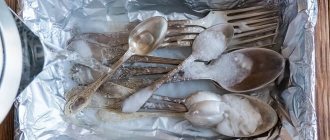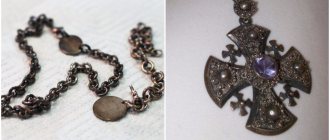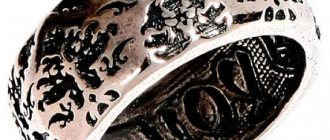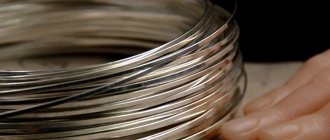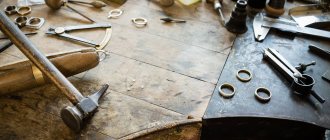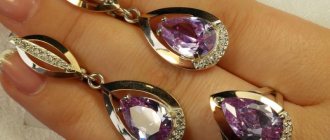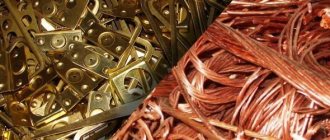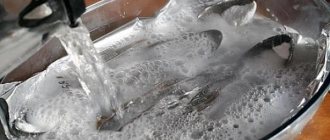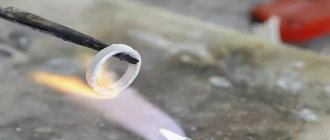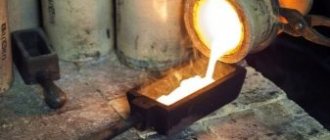Not every family can boast of having silver cutlery, and there are very few owners of complete sets. It would seem that silver is not a very expensive metal - a simple ring can be purchased for only a thousand rubles.
Why is silverware so expensive? And you count how much precious metal it takes to make one silver spoon. Plus work, a brand and other extras - a substantial amount accumulates.
Therefore, often the desire to determine the authenticity of silver spoons is not a whim, but a matter of prestige, the feasibility of financial investments and the characteristics of care. Especially if we are talking about family or any other rare silver.
Cupronickel as an imitation of silver
Cupronickel has a lot in common with silver in appearance.
Silver is a precious, expensive metal, from which not only dishes were made, but also jewelry, coins, and figurines. Silver is often replaced with similar and inexpensive cupronickel. That is why it is important to distinguish cupronickel from silver in a store, market, souvenir shop or at home.
Cupronickel is an alloy of copper, nickel and zinc. Outwardly, cupronickel is very similar to silver, which is what many take advantage of by selling counterfeits of cupronickel under the guise of this precious metal. In everyday life, there may be difficulties in solving the problem of distinguishing nickel silver products from silver products.
Historically, cupronickel has been a good imitation of silver. The color of such an alloy depends on the percentage of copper in its composition and can vary from yellowish to red-yellow shades. Manganese and iron are added to make the material resistant to corrosion. Cupronickel products have a pleasant silvery sheen.
Cupronickel is traditionally used to create dishes and jewelry that perfectly imitate silver items. It often happens that people try to pass off nickel silver items as silver.
Cupronickel silver products are often coated with silver. Cupronickel silver-plated cutlery and crockery look like real silverware. Therefore, when buying silver jewelry and cutlery, we need to look very carefully at what we are buying.
In order not to buy a cheap fake cupronickel alloy, you need to use simple methods that allow you to quickly find cupronickel.
Advantages and disadvantages
Cupronickel tableware has many advantages over products made from other materials. The main ones:
- slow heating, which is extremely important for appliances used in the kitchen;
- cupronickel products have a beautiful appearance;
- the material does not suffer from corrosion;
- metal does not bend, because has high strength;
- Cupronickel has a positive effect on the human body, because contains nickel and copper ions;
- the metal has a more affordable price than silver.
In addition, this material has a significant service life and has a positive effect on the human body. It is as follows:
- Nickel ions, concentrating in the human body, stabilize the glucose balance, which is extremely important for patients with diabetes;
- these compounds stabilize blood pressure in hypertension;
- copper is required by the body for the stable course of protein metabolism processes and maintaining the functioning of the musculoskeletal system;
- this microelement has a slight antibacterial effect.
Medical experts note that regular use of spoons, forks and knives made of nickel and copper alloy can improve overall well-being, eliminate increased nervousness and aggression, and also minimize the manifestation of seasonal vitamin deficiencies.
Disadvantages of the material:
- Cutlery, dishes and jewelry made of copper-nickel alloy quickly lose their original attractiveness. Dark marks and deposits on the surface are a natural process that is activated due to the oxidation of the material. This metal deficiency is considered the main one.
- Things made from this alloy require regular and proper care. Due to the fact that devices made from this material darken, they must be cleaned regularly to restore their beauty.
- Nowadays it is difficult to find things made from high-quality cupronickel, because... they are produced in small batches.
- Some believe that devices made from this metal have already gone out of fashion. However, this “minus” can at the same time be considered an advantage if we consider a spoon or fork from the times of the USSR as an antique.
In addition, cupronickel is harmful to the body when it is heated, so products made from it are additionally treated with a protective metal coating. The inside of such dishes is gold-plated, silver-plated or tin-plated, chrome-plated or nickel-plated.
Cupronickel alloys
Cupronickel alloys can have different percentage compositions of substances. The most popular cupronickel alloy contains from 5 to 30 percent nickel, with the remaining percentages being iron (0.8 percent) and manganese (0.1 percent).
There are other alloys that are very similar in their chemical composition to cupronickel, but have different names:
- Cupronickel contains only copper and nickel in equal proportions;
- Monel, contains up to 67 percent nickel;
- nickel silver, contains additional zinc;
- Constantan contains 55 percent copper and 45 percent nickel.
Cupronickel products are easily soldered and polished. In the manufacture of cupronickel products, special solders based on tin-lead or silver alloys can be used. Cupronickel is well processed, alloyed with other metals, cut, forged, embossed, stamped, polished and soldered. Such properties of cupronickel make it possible to effectively use it to replace natural silver.
The attractive appearance has allowed the copper alloy to occupy a stable niche in jewelry, no longer for counterfeiting silver items, but as an independent alloy.
Story
The Chinese were the first to obtain nickel silver from metals back in the 3rd century BC. But the alchemists of the Celestial Empire did not discover the secret of “white copper”.
Europeans unraveled the secret two millennia later:
- The French Maillot and Chaurier received the alloy by 1819.
- According to their authentic spelling – Maillot + Chorier – the alloy was christened.
- However, the term entered history modified: the Melchior variant seemed more harmonious to the Germans, and then to other peoples.
Melchior was the name of one of the trinity of wise men who came with gifts to the newborn baby Christ.
- In Russia (USSR), the term took hold by the 1930s, displacing the “German composition”, “serebrovid” and other variants.
- In Europe the term Cupronickel is in circulation.
An alloy that resembles a noble metal in description is also called Nickel silver, German silver, New silver (nickel, German, new silver).
Ten reliable ways to distinguish cupronickel from silver
10 ways to distinguish cupronickel from silver:
- the abbreviation MNC (an alloy of copper, nickel and zinc) indicates that it is cupronickel;
- Cupronickel silver becomes covered with a green coating when left in the water for a long time;
- the action of the lapis pencil will not change the silver, but a dark spot will appear on the cupronickel;
- you can use weighing - cupronickel is lighter than silver;
- cupronickel has the smell of copper;
- silver darkens when exposed to iodine solution in the sun;
- reaction to nitric acid - silver will darken, and the copper alloy will give a green tint;
- reaction to chalk - silver darkens, cupronickel does not change color;
- the action of a magnet, silver is not magnetic, and cupronickel may have weak magnetic properties (depending on the composition of the metals);
- the effect of oxidation - silver cannot have traces of rust; if there are any, it is definitely not silver.
If the product is made of nickel silver and then coated with a thin layer of silver, then in order to find a fake it will be enough to scratch it with a thin tool in an inconspicuous place. If the color in the depth of the product is different, then cupronickel or even cheaper metal was probably used.
Another simple (but not accurate) method is to heat the product being tested, for example, by rubbing it on your hand; silver has high thermal conductivity and will heat up much faster than cupronickel.
Use the methods described in our article to easily distinguish cupronickel from silver, and enjoy a successful purchase!
Application area
For the manufacture of kitchen utensils and decorative accessories, an alloy marked MH25 is used. In addition, instruments and equipment for medical purposes (clamps, ophthalmoscopes, scalpels, tweezers, etc.) are produced on the basis of cupronickel. In spoons, knives and forks, the alloy additionally includes zinc. Material with the addition of manganese is often used in the manufacture of coins.
Coatings based on a copper-nickel alloy are often used to equip automotive parts and mechanisms that require reliable and durable protection against corrosion. Alloys are also used in units and components of marine transport. Cupronickel silver is used to produce fittings, shut-off valves and pipelines.
In electrical engineering, the alloy is used for the manufacture of thermogenerators and precision resistors. Constantan (a type of cupronickel) is used in the assembly of rheostats for heating elements of electric furnaces, extension wires and thermocouples.
About silver
Since ancient times, silver has been valued for its beauty and physical qualities. In nature, it is found in the form of nuggets, sometimes reaching enormous sizes; the largest nugget found during smelting yielded 20 tons of pure silver. Unfortunately, most of the silver that can be found is found in combination with other substances, which makes it very difficult to smelt pure metal nuggets. If we talk about the physical properties of silver, then special attention is paid to its ductility; from 1 g of silver the thinnest wire 2 km long is obtained, as well as the fact that this metal is considered precious and is used by jewelers - its ability not to oxidize under the influence of oxygen.
Storage and cleaning of cupronickel products
Items made from this metal alloy must be kept in a dry place. Cutlery and utensils require regular cleaning and removal of residual moisture after each use, otherwise dark streaks and stains will appear on the products.
It is necessary to clean things only with soda powder and running water or a specialized preparation. If these remedies do not provide a positive effect, the surface can be treated with dry powder for cleaning teeth or crushed chalk. It must be taken into account that such processing increases the risk of scratches that spoil the appearance of the product.
It is prohibited to use preparations for cleaning gas stoves and sinks, because... they contain too large abrasive particles.
If the dark coating does not disappear, the items should be boiled in a solution of water and soda. To do this, pour 1 liter of water into an aluminum container and add 50 g of powder to it. The solution is brought to a boil, after which an object made of an alloy of nickel and copper is lowered into it. The product is boiled for about an hour, then washed with running water and wiped dry. Additionally, you can rub it with baking soda.
To maintain the attractive shine and shade of nickel and copper appliances, they should be regularly wiped with a soft cloth soaked in a mild soap solution.
In addition, a set of copper-nickel dishes or cutlery must be stored in a special case. This will protect them from oxidation, dust, mechanical stress and other negative factors. If there is no case, each plate or spoon can be wrapped in a soft cloth. At the same time, things should not be placed next to household chemicals, because they may darken and oxidize.
If there are scratches on the product, you can try to polish them using fine-grained salt, baking soda powder or fine sandpaper.
How to distinguish metals?
There are several proven methods that are used to inspect a home.
Magnet
Not everyone knows this method of distinction, because not everyone can immediately answer, cupronickel or silver, which attracts a magnet better? And in general, is nickel silver magnetic or not? To answer these questions, you need to delve into the physical properties of these metals. Silver is not ferromagnetic, which means that when you approach a magnet, it will not be magnetized to it.
Is cupronickel magnetic ? It was indicated above that it consists of non-ferrous metals that have different magnetism properties. Thus, iron and nickel are ferromagnetistic, while copper and manganese are not magnetic. Taking into account the fact that copper in the cupronickel alloy is from 70 to 95%, it is not able to be attracted to a magnet. This method of verification is not justified.
Sewing needle
Often, jewelry and tableware made from cupronickel are silvered on top, covering them with a thin layer, which makes them even more similar to the precious metal. Using a needle you can distinguish metals. To do this, you need to carefully scratch the product with a needle in an inconspicuous place. If dark metal appears inside the damage, then this is a nickel silver manufacturing option.
Nitric acid
Ordinary nitric acid will help to distinguish silver from cupronickel; it and other reagents are used to check the authenticity of the metal in jewelry stores. It is enough to scratch the surfaces a little and drip the composition. The reaction will be different, the silver will darken, and the copper alloy will give a green tint.
How to tell if a spoon is silver
Silver is a precious metal, which means that all products made from it are subject to hallmarking. In addition to the required image, the mark contains numbers reflecting the percentage of metal content.
Nowadays three-digit hallmark designations are accepted, but in tsarist Russia they were two-digit. And the brand looked completely different.
Pure silver is used exclusively for technical purposes. In the production of jewelry and decorative items, as well as cutlery, silver is used with additives that give it strength.
The most popular additives for silver are copper and nickel. This is why silverware often has a yellowish tint - these are traces of copper. The higher the sample, the less noticeable this yellowness is.
Set of silver teaspoons
So factory-made silverware is always hallmarked, but there is still a risk of running into a fake - craftsmen have learned to falsify even standard hallmarks. However, silver is supplied with fake hallmarks much less often than gold (simply unprofitable), and the quality of the imprint itself leaves much to be desired.
If there is no mark on the product or you doubt its origin, you can check the silverware for authenticity using homemade methods:
- Chalk. Run a regular chalk across the surface of the silver - a dark mark will remain on the white mineral. True, some other metals (for example, tin) demonstrate a similar reaction, so this test is not very informative.
- Sulfur ointment. Sulfur is the worst enemy of silver: upon contact with it, the noble metal is covered with a dark layer of sulfide. Apply sulfur ointment to a small, inconspicuous area, wait 10-15 minutes and watch the metal react.
- Lapis pencil. The ancient styptic can be used to test gold and silver. It contains silver nitrate, and it does not leave the slightest trace on precious metals.
- Iodine. But silver reacts to iodine - dark spots remain. If the spots are a different color or there is no reaction at all, then this means that this is a fake. The only disadvantage of this method is that it is difficult to remove a dark stain from silver later.
- Ice. Silver has high thermal conductivity: a piece of ice placed in a spoon will begin to melt rapidly. To compare the result, it is advisable to simultaneously perform a similar experiment with a guaranteed non-silver spoon.
How to find out if a spoon is a silver spoon or not: getting results at home
Not every family can boast of having silver cutlery, and there are very few owners of complete sets. It would seem that silver is not a very expensive metal - a simple ring can be purchased for only a thousand rubles.
Why is silverware so expensive? And you count how much precious metal it takes to make one silver spoon. Plus work, a brand and other extras - a substantial amount accumulates.
Therefore, often the desire to determine the authenticity of silver spoons is not a whim, but a matter of prestige, the feasibility of financial investments and the characteristics of care. Especially if we are talking about family or any other rare silver.
Magnet
A less reliable, but still valid method for distinguishing silver from other metals is a magnet. Very often I insert silver parts into products made from ordinary, base metals. For example, these could be links in a chain with a sample. In this case, a magnet can help; silver is never attracted to it. But this method is not reliable, since not only does the magnet not attract silver, but cupronickel and non-ferrous metals also do not react to the magnet.
Another common way to counterfeit silver jewelry or tableware is to coat copper or other metal with a thin layer of silver. In this case, a regular needle can help distinguish a fake. It is enough to scratch the product with it, and if dark metal appears inside, then it is definitely a fake. However, this method is not suitable for those who are afraid of ruining the appearance of the item.
Tactile method
There are several tactile ways to distinguish silver from cupronickel and other fakes. One of them was described above, namely, to heat the product. But, in addition to temperature, after heating an object by rubbing it with your hand, you should pay attention to the skin. If there are no stains left on it, most likely it is high-quality silver, but dark marks remaining on the skin indicate that the product contains too much zinc, which is harmful to the body, and you should not wear such jewelry or use such utensils.
The authenticity of silver can also be determined by the weight of the item: silver is much heavier than other metals. This task is best handled by a professional, but an ordinary person can determine its authenticity by simply comparing the weight of the item with a similar silver one.
